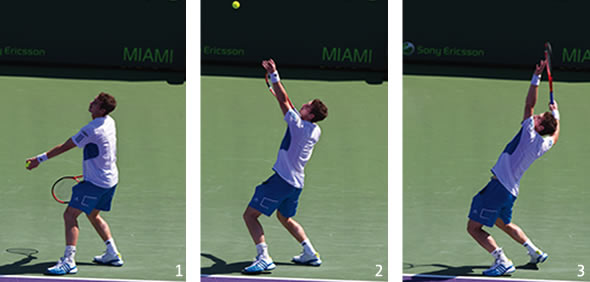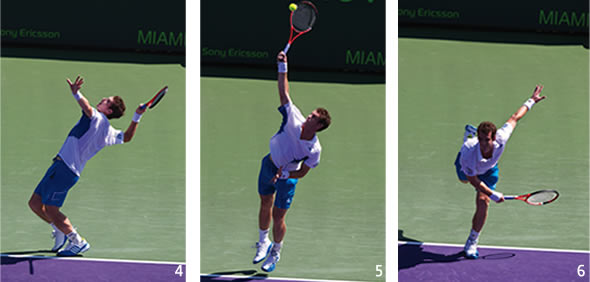
Serve Big like Andy Murray
The Scot’s serve is arguably the most improved shot in his arsenal since that first outing at Wimbledon five years ago.
1. Murray starts the winding up process, taking his racket back as he prepares to toss the ball. His feet and shoulders are in the classic side-on position to the target box.
Murray’s left foot position is slightly unorthodox - it is almost parallel to the baseline.
2. Both Murray’s arms move up together in sync as his legs start bending to prepare for the drive upwards towards the contact point. Simple and ¬efficient.
3. His arms are still in sync with the upper body in a lovely 'bow' position, and his legs are now fully loaded. Murray begins to bring his back foot up next to his leading foot for take-off. Notice how well he keeps his right elbow up. He could get a bit more rotation from his right shoulder to increase the pre-stretch of his chest muscle.
OBJECTIVES | ANTICIPATE THE RETURN
Few players can serve aces at will, so make your preparations for the next ball a part of your serving routine. The key is balance – Murray’s right leg will quickly come down as he hops onto¬ his left foot to be ready for the next ball. If you are unbalanced after the serve, the extra step you take to recover could delay you enough to drastically a¬ffect your ability to deal with a hot return.
TACTICS | AWESOMEAD - COURT FOURSOME
Right-handers serving from the left of the centre mark (and lefties stood to the right) have a range of options available to them, each with strengths and weaknesses. A flat rocket serve out wide is very effective, but a low-percentage play as it is over the high point on the net. The slice serve swinging down the T is also effective but has to swing back past the centre line for maximum effect – or it lands in the slot giving an easy forehand return. Mix both these serves in with a good high-percentage kick serve out wide and the odd slice serve into the body, and you become a player who uses the serve in a smart way.
4. The sloping straight line from left wrist to his right elbow gives Murray the almost perfect pre-stretch of his chest muscles, leaving him poised to drive his racket up at the ball and into the court.
5. Murray’s racket is travelling from right to left as we look at the image, so we know it's a kick serve. His head is up, his racket arm is fully extended, and his legs have pushed him upwards.
6. As he lands inside the court, Murray’s head has not dropped an inch. His right leg and left arm are extended backwards to counterbalance the momentum which takes his body forward.
His upper body remains strong and tall throughout the serve - a sign of a strong core
Look how his shoulders are slightly more rotated than his hips, so he can rotate his torso into the serve for more power
That strong core has prevented Murray’s upper body from buckling and his head from dropping during his serve - two typical serving errors. If there is one criticism of the serve is the ball toss can get a little high and this can be difficult to time under pressure as he has to wait a split second before he drives up to the ball.
CONDITIONING | GIVE YOURSELF A LEG UP
Leg strength is extremely important to virtually every stroke in tennis, in particular the serve. The power and weight of shot begins from driving upwards, biomechanically known as ‘ground force’. Strong legs increase the power, the weight of shot and the height from which you hit the serve, giving you the maximum angle from which to hit down into the service box. Squats are effective but please consult a qualified physical trainer because good technique is crucial to learning squats without causing injury.
GOLDEN RULES
- Aim to make contact with the ball at the highest point. That way, you can generate more power and it will be possible to hit a greater proportion of the service box.
- Keep the head up after contact. Dropping the head will drop the shoulders and pull the ball down into the net.
- At a minimum land on the baseline but preferably inside the baseline after contact. This helps get weight into and behind the serve.
- Land with balance. If you are losing balance and have to fall one way or another this means your ball toss is not placed well enough for you to swing with balance. Correct this by serving keeping the left foot still and only allowing the right foot to raise the heel (left and right for left-handed players). Effectively this means serving without moving the feet maintaining your balance.
Images by: AMN Images

